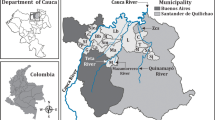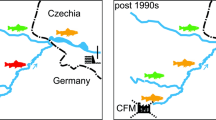Abstract
Introduction
A mercury (Hg) processing plant previously operating in KwaZulu-Natal Province (South Africa) discharged Hg waste into a nearby river system causing widespread contamination since the 1980s. Although the processing plant ceased operation in the 1990s, Hg contamination (due to residual Hg) remains significant. Previous studies in the area since the plant’s closure have found elevated Hg concentrations in fish, and that these concentrations were as a direct consequence of widespread contamination of the Hg processing plant operations conducted between the 1980s and 1990s.
Objectives
This study aimed at investigating the impacts of residual Hg almost 20 years after the plant’s closure.
Methods
Water, sediment and biota (invertebrates and fish) were collected in water resources in the vicinity of the processing plant to determine the Hg concentrations in these compartments, as a proxy for assessing the extent to which residual Hg that is reintroduced to the water column becomes bioavailable to biota. For water and sediment samples, higher total mercury (TotHg) and methylmercury (MeHg) concentrations were measured at sampling sites immediately downstream of the Hg processing plant when compared to the upstream sites, while concentrations decreased with distance from the plant. Fish MeHg concentrations measured just below the US EPA guideline for Hg in fish muscle tissue.
Results
The results show that the historically Hg-contaminated river system is a potential Hg pollution source due to the residual Hg present in sediment. Any dredging of sediment as a form of remediation in the Mngceweni River is not recommended; however, a Hg monitoring programme is recommended for assessing the bioavailability of resuspended Hg from sediment.






Similar content being viewed by others
Abbreviations
- CVAFS:
-
Cold vapour atomic fluorescence spectrometry
- DOC:
-
Dissolved organic carbon
- DO:
-
Dissolved oxygen
- Hg:
-
Mercury
- TotHg:
-
Total mercury
- MeHg:
-
Methylmercury
- OM:
-
Organic matter
- US EPA:
-
United States Environmental Protection Agency
References
Babiarz CL, Hurley JP, Benoit JM, Schafer MM, Andren AW, Webb DA.(1998) Seasonal influences on partitioning and transport of total and methylmercury in rivers from contrasting watersheds. Biogeochem., 43:237–257
Barrat GJ, Combrink J (2002) An Assessment of the degree of mercury (Hg) bio-transformation in two river systems following discharges from a mercury recovery plant. Water SA Special Edition: WISA Proceedings 2002
Benoit JM, Gilmour CC, Mason RP, Heyes A (1999) Sulfide controls on mercury speciation and bioavailibility in sediment pore waters. Environ Sci and Technol 33:951–957
Benoit JM, Gilmour CC, Heyes A, Mason RP, Miller CL (2002) Geochemical and biological controls over methylmercury production and degradation in aquatic ecosystems. ACS Symposium Series.
Berzas Nevado JJ, Garcia Bermejo LF, Rodrigues Martin-Doimeadios RC (2003) Distribution of mercury in the aquatic environment at Almaden, Spain. Environ Pollut 122:261–271
Bloom NS, Fitzgerald WF (1988) Determination of volatile mercury species at the pictogram concentration by low temperature gas chromatography with cold-vapour atomic fluorescence detector. Anal Chim Acta 208:151–161
Boudou A, Ribeyre F (1997) Mercury in food web: accumulation and transfer mechanisms. Met Ions Biol Syst 34:289–319
Boylan HM, Richter RC, Kingston HM, Ricotta A (2001) Rapid mercury analysis for the field: method development and application to natural gas utility sites. Water Air Soil Pollut 127:255–270
Bravo AG, Loizeau J-L, Ancey L, Ungureanu VG, Dominik J (2009) Historical record of mercury contamination in sediments from the Babeni reservoir in the Olt River, Romania. Environ Sci Technol 16:S66–S75
Cabana G, Tremblay A, Kalff J, Rasmussen JB (1994) Pelagic food chain structure in Ontario Lakes: a determinant of mercury concentrations in Lake Trout. Can. J. Fish Aquat Sci. 51: 381-389
Cardona-Marek T, Schaefer J, Ellickson K, Barkay T, Reinfelder JR (2007) Mercury speciation, reactivity, and bioavailability in a highly contaminated estuary, Berry’s Creek, New Jersey Meadowlands. Environ Sci Technol 41:8268–8274
Conaway CH, Squire S, Maon RP, Flegal AR (2003) Mercury speciation in the San Francisco Bay estuary. Mar Chem 80:19–225
Covelli S, Faganeli J, Horvat M, Brambati A (1999) Porewater distribution and benthic flux measurements of mercury and methylmercury in the Gulf of Triest. Estuar Coast Shelf Sci 48:415–428
CRC Press (1997) In: Liley D (ed) Handbook of chemistry and physics, 78th edn. CRC, Raton
DWAF (Department of Water Affairs and Forestry) (1996) Water quality guidelines, aquatic ecosystem use Vol. 7, 1st edn. Department of Water Affairs and Forestry, Pretoria
Eggleton JA, Thomas KV (2004) A review of factors affecting the release and bioavailability of contaminants during sediment disturbance events. Environ Int 30:973–980
Fan W, Wang W-X, Chen J, Li X, Yen YF (2002) Cu, Ni and Pb speciation in surface sediments from a contaminated bay of northern China. Mar Pollut Bull 44:816–832
Gilbertson M, Carpenter DO (2004) An ecosystem approach to the health effects of mercury in the Great Lakes basin ecosystem. Environ Res 95:240–246
WHO (World Health Organisation) (1990), Environmental Health Criteria 101: Methylmercury. Geneva
Heyes A, Miller C, Mason RP (2004) Mercury and methylmercury in Hudson River sediment: impact of tidal resuspension on partitioning and methylation. Mar Chem 90:75–89
Johnston P, Stringer R, French MC, Vallette J (1991) Contamination of soils in the vicinity of a mercury recovery plant. Bull Environ Contam Toxicol 46:74–78
Kim E-H (2004) The importance of physical mixing and sediment chemistry in mercury and methylmercury biogeochemical cycling and bioaccumulation within shallow estuaries. PhD thesis, University of Maryland, College Park
Kim E-H, Mason RP, Porter ET, Soulen HL (2006) The impact of resuspension on sediment mercury dynamics, and methylmercury production and fate: a mesocosm study. Mar Chem 102:300–315
Knott NA, Aulbury JP, Brown TH, Johnston EL (2009) Contemporary ecological threats from historical pollution sources: impacts of large-scale resuspension of contaminated sediments of sessile invertebrate recruitment. J Appl Ecol 46:770–781
Lawrence AL, Mason RP (2001) Factors controlling the bioaccumulation of mercury and methylmercury by the estuarine amphipod Leptocheirus plumulosus. Environ Pollut 111:217–231
Leaner JJ, Mason RP (2002) Methylmercury accumulation and fluxes across the intestine of channel catfish, Ictalurus punctatus. Comp. Biochem. Physiol Part C132: 247-259
Leaner JJ, Mason RP (2004) Methylmercury uptake and distribution kinetics in sheepshead minnows, Cyprinodon variegates, after exposure to CH3Hg-spiked food. Environ Toxicol Chem 23(9):2138–2146
Lee CL, Fang MD, Hsieh MT (1998) Characterization and distribution of metals in surficial sediments in Southwestern Taiwan. Mar Pollut Bull 36(6):464–471
Mason RP, Lawrence AL (1999) Concentration, distribution, and bioavailability of mercury and methylmercury in sediments of Baltimore Habour and Chesapeake Bay, Maryland, USA. Environ Toxicol Chem 18:2438–2447
Mason RP, Sullivan KA (1998) Mercury and methylmercury transport through an urban watershed. Water Res 32:321–330
Mason RP, Fitzgerald WF, Morel FMM (1994) The biogeochemical cycling of elemental mercury: anthropogenic influences. Geochim Cosmochim Acta 58:3191–3198
Mason RP, Laporte JM, Andres S (2000) Factors controlling the bioaccumulation of mercury, methylmercury, arsenic, selenium and cadmium by freshwater invertebrates and fish. Arch Environ Contam Toxicol 38:283–297
Mason RP, Kim E, Cornwell J, Heyes D (2006) An examination of the factors influencing the flux of mercury, methylmercury and other constituents from estuarine sediments. Mar Chem 102:96–110
Oosthuizen J, Ehrlich R (2001) The impact of pollution from a mercury processing plant in Kwa-Zulu Natal, South Africa, on the health of fish-eating communities in the area: an environmental health risk assessment. Int J Environ Health Res 11:41–50
Papu-Zamxaka V, Mathee A, Harpham T, Barnes B, Rollin H, Lyons M, Jordaan W, Cloete E (2010) Elevated mercury exposure in communities living alongside the Inanda Dam, South Africa. J Environ Monit 12(2):472–477
Pereira ME, Lillebo AI, Pato P, Valega M, Coelho JP, Lopes CB, Rodrigues S, Cachada A, Otero M, Pardal MA, Duarte AC (2009) Mercury pollution in Ria de Aveiro (Portugal): a review of the system assessment. Environ Monit 155:39–49
Pestana MHD, Formoso MLL (2003) Mercury contamination in Lavras do Sul, south Brazil: a legacy from past and recent gold mining. Sci Total Environ 307:125–140
Ravichandran M. (2004) Interactions between mercury and dissolved organic matter – a review. Chemos. 55: 319-331
Regnell O, Watras CJ, Troedsson B, Helgee A, Hammar T (2009) Mercury in a boreal forest stream—role of historical mercury pollution, TOC, temperature, and water discharge. Environ Sci Technol 43:3514–3521
Ruelas-Inzunza J, Paez-Osuna F, Zamora-Arellano N, Amezcua-Martinez F, Bojorquez-Leyva H (2009) Mercury in biota and surficial sediments from Coatzacoalcos Estuary, Gulf of Mexico: distribution and seasonal variation. Water Air Soil Pollut 197:165–174
Scheuhammer AM, Graham JE (1999) The bioaccumulation of mercury in aquatic organisms from two similar lakes with differing pH. Ecotoxicol 8:49–56
Snyder CD, Hendricks AC (1997) Genetic responses of Isonychia bicolour (Ephemeroptera: Isonychiidae to chronic mercury pollution. JN Am Benthol Soc 16(3):651–663
Thomas MA, Conaway CH, Steding DJ, Marvin-DiPasquale M, Abu-Saba KE, Flegal R (2002) Geochemistry: exploration. Environ Anal 2:211–217
Turner RR, Lindberg ST (1978) Behaviour and transport of mercury in river-reservoir system downstream of inactive chloalkali plant. Environ. Sci. Technol. 0013-936X/78/0912-0918$01.00/0
United Nations Environment Protection Programme (UNEP) (2002) Global mercury assessment report. UNEP, Geneva
Urban SR, Correa AXR, Schettini CAF, Schwingel PR, Sperb RM, Radetski CM (2010) Physiochemical and ecotoxicological evaluation of estuarine water quality during a dredging operation. J Soils Sediments 10:65–76
US EPA (United States Environmental Protection Agency) (1992) Water quality standards: establishment of numeric criteria for priority toxic pollutants; states’ compliance; final rule. Federal Register 40, CFR Part 131, v 57, Washington DC, USA, 246(60): 847–860.
US EPA (United States Environmental Protection Agency) (1996) Method 1669: sampling ambient water for trace metals at EPA water quality criteria levels. EPA publication no.: 821-R-96-008. Washington DC, USA.
US EPA (United States Environmental Protection Agency) (2000a) Guidance for assessing chemical contamination data for use in fish-advisories. Vol 1: field sampling and analysis, Third Ed. EPA publication no. EPA-823-B-00-007. Washington DC, US EPA, Office of Water
US EPA (United States Environmental Protection Agency) (2000b) Guidance for assessing chemical contamination data for use in fish advisories, Vol 2: Risk assessment and fish consumption limits, Third Edition. EPA Publication No. EPA-823-B-00-008, Washington DC, USA
US EPA (United States Environmental Protection Agency) (2001a) Method 1630: Methylmercury in water by distillation, aqueous ethylation, purge and trap, and CVAFS. EPA Publication No. 821-R-01-020. Washington DC, USA.
US EPA (United States Environmental Protection Agency) (2001b) Mercury update: impact on fish advisories. EPA-823-F-01-012. US EPA, Washington DC.
US EPA (United States Environmental Protection Agency) (2002) Mercury in water by oxidation, purge and trap, and cold water atomic fluorescence spectrometry. EPA Publication No.: EPA-821-R-02-019. Washington DC, USA.
Warner KA, Bonzongo JJ, Roden EE, Ward GM, Green AC, Chaubey I, Lyons WB, Arrington DA (2005) Effect of watershed parameters on mercury distribution in different environmental compartments in the Mobile Alabama River Basin, USA. Sci Total Environ 347:187–207
Watras CJ, Back RC, Halvorsen S, Hudson RJM, Morrison KA, Wente SP (1998) Bioaccumulation of mercury in pelagic freshwater food webs. Sci Total Environ 219:183–208
Acknowledgements
This research was undertaken with funding received from the Water Research Commission, National Research Foundation and the CSIR Parliamentary Grant and Strategic Research Panel. The authors wish to thank Prof. Robert Mason and Ms Genevieve Bernier (Department of Marine Sciences, University of Connecticut), Chantel Petersen and other field personnel. Note: Dr Joy Leaner participated in this research while employed at the CSIR; this assessment does not reflect the views of her current employer.
Author information
Authors and Affiliations
Corresponding authors
Additional information
Responsible editor: Thomas Braunbeck
Rights and permissions
About this article
Cite this article
Williams, C.R., Leaner, J.J., Somerset, V.S. et al. Mercury concentrations at a historically mercury-contaminated site in KwaZulu-Natal (South Africa). Environ Sci Pollut Res 18, 1079–1089 (2011). https://doi.org/10.1007/s11356-011-0458-8
Received:
Accepted:
Published:
Issue Date:
DOI: https://doi.org/10.1007/s11356-011-0458-8




